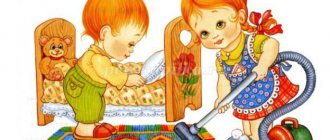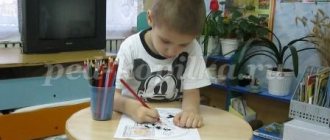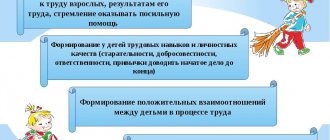The role of work activity in the moral education of preschool children
The role of work activity in the moral education of preschool children
Senior teacher of the children's school "Beryozka" r.p. Chishmy
Khairullina Gulnara Akhkametdinovna
The work of preschool children is the most important means of education. Labor activity is an activity aimed at creating socially useful products - material and spiritual values necessary for humanity. Both in its results and in its organization, labor is a social activity. The entire process of raising children in kindergarten can and should be organized in such a way that they learn to understand the benefits and necessity of work for themselves and for the team, to be able to coordinate their actions with the actions of other labor participants, and to jointly achieve a common goal. Treating work with love and seeing joy in it is a necessary condition for the manifestation of a person’s creativity and talents.
Labor activity develops during preschool childhood from the most elementary to relatively complex types and forms. In a children's team, a public opinion is formed about the actions and behavior of peers, about the quality of work performed, about the friend's attitude towards adults and children's relationships. The labor process can be difficult to one degree or another, associated with tension, effort, and overcoming external and internal obstacles. Therefore, labor places particularly high demands on volitional qualities - the ability to subordinate actions to a specific goal, consciously regulate them, and overcome emerging difficulties.
Fostering a correct attitude towards work means not only including children in work activities, but also teaching them to respect work, understand its importance in life, and come to the aid of others without waiting for a request. At the same time, it is very important to instill in a child a positive attitude towards work to make his work activity the main criterion for assessing his personality (primarily activity in work, which the child performs out of personal motivation, independently, without the control of an adult.
Therefore, the tasks of labor education of preschool children are as follows:
- to develop the prerequisites for work;
- develop labor skills;
- improve them, gradually expanding the content of children’s work activities;
- to cultivate important personal qualities: the habit of work effort, responsibility, caring, thrift, hard work, willingness to participate in work, show perseverance, the ability to get involved in work when necessary;
- learn to establish a connection between the beginning of a task and the final result, explain the significance of work, and cultivate a caring attitude towards its results;
- to form the beginning of a responsible attitude to the task, the ability and desire to complete the task, the desire for high-quality implementation;
- to form a work culture: to develop basic skills in planning and organizing one’s own and general work, the ability to outline its sequence, distribute responsibilities between participants, prepare everything necessary for work, use equipment correctly, put everything back in place after the end of the work process;
- learn to coordinate actions with the actions of comrades, see the need for help, and provide it on your own initiative.
In the Encyclopedic Dictionary, the concept of “labor” is interpreted as “purposeful human activity aimed at modifying and adapting objects of nature to satisfy one’s needs.” Labor is the most important means of education, starting from preschool age; In the process, the child’s personality is formed and collective relationships are formed.
“Labor has always been the basis for human life and culture. Therefore, in educational work, work should be one of the most basic elements” (A. S. Makarenko). A. S. Makarenko has repeatedly emphasized that preschool age is extremely responsible in the development of moral character traits. Numerous pedagogical and psychological studies confirm that it is during these years, subject to targeted education, that the foundations of the moral qualities of an individual are laid.
“The joy of work is a powerful educational force. During childhood, a child must deeply experience this noble feeling. Labor for the people is not only a vital necessity, without which human existence is impossible, but also a sphere of multifaceted manifestations of spiritual life, the spiritual wealth of the individual. The richness of human relationships is spread through work. It is impossible to cultivate a love of work if the child does not feel the beauty of this relationship. People see work as the most important means of self-expression and personal self-affirmation. Without work, a person becomes an empty place. An important educational task is that the sense of personal dignity and personal pride of each pupil is based on labor success,” believed V. A. Sukhomlinsky.
K. D. Ushinsky believed that labor is a necessary condition for the proper development of man. In an extensive article “Labor in its mental and educational significance,” he noted that labor is the main factor in the creation of material values and is necessary for the physical, mental and moral improvement of man, for human dignity, for human freedom and his happiness.
According to K. D. Ushinsky, “education, if it wishes a person happiness, should educate him not for happiness, but prepare him for the work of life.” Education should develop in a person love and the habit of work. K. D. Ushinsky attached great importance to physical labor, considered it very useful for a person to combine physical and mental labor in his activities, and emphasized the great educational importance of agricultural labor (especially in rural schools). Speaking about work, he pointed out that “teaching is work and must remain work, but work full of thought.” Ushinsky’s indications of the great educational importance of labor, his idea that “learning is work and serious work...” are of great value for pedagogy even today.
Diverse types of work
are not the same in their pedagogical capabilities, their meaning changes at one or another age stage. If, for example, self-care has greater educational significance in younger groups - it teaches children to be independent and equips them with skills to overcome difficulties, then at the senior preschool stage this work does not require effort and becomes habitual for children. When assessing the educational significance of self-service, first of all, one should note its vital necessity, its focus on meeting the child’s everyday personal needs. Daily fulfillment of basic work tasks accustoms children to systematic work. Children begin to understand that everyone has work responsibilities related to their daily needs. This helps to cultivate a negative attitude towards idleness and laziness.
Usually, an adult quite easily manages to arouse the desire to work in children of senior preschool age. This is explained by children’s desire for active practical action, to imitate adults, sincere trust in them, and their increased emotionality.
At the same time, children experience a discrepancy between the desire to work and the ability to take part in work. Thus, the desire to work develops faster than mastery of work skills. Insufficient physical development compared to adults, unstable attention, underdeveloped willpower, self-control - all this leads to the fact that children, although they have a great desire to work, find themselves unable to work and are switched off from the labor process ahead of time. As a result, their work often ends in failure and, therefore, does not bring them joy or satisfaction.
Therefore, when organizing the work of children of senior preschool age, it is necessary to take into account such factors as the feasibility of work, switching to other types of work, changing working posture (this relieves physical fatigue and promotes concentration), and the correct alternation of work and rest for children.
The content of labor is realized in different forms of organization
. Various forms of organizing the work of preschool children have been developed in science and put into practice.
In work, both business and personal relationships develop between children. The regulation of relationships is carried out on the basis of already learned moral norms and rules. In joint activities, divided into separate operations, children evaluate everyone’s actions. Particular attention of preschoolers is drawn to the fact that work is delayed and cases of poor quality completion of the task. This requires adjusting the actions of the lagging behind and providing him with assistance. Children in irritation may call a friend names, propose to exclude him from the common cause, etc. Children should be helped to find ways to overcome difficulties that have arisen, and reminded of the rules of behavior in a team.
Work develops such personality qualities as responsibility, hard work, discipline, independence and initiative.
Performing certain feasible work duties helps to develop a child’s sense of responsibility, goodwill, and responsiveness. For the formation of all these qualities, the family has the most favorable conditions. Here all affairs and concerns are common. Working together with parents or other family members encourages the child to help each other and do something for everyone. Thus, he lays the foundations of the moral qualities necessary for life in society.
In the family, children constantly see what their parents are doing: preparing food, cleaning the apartment, washing clothes, sewing; participation in household work is important. Domestic work cultivates neatness, responsibility, hard work and other useful qualities. The main types of work that educate and develop a child as a person are equipment and cleaning the house, housekeeping, participation with parents in solving financial issues, cooking, making household items, as well as caring for animals and plants. Caring for your own home develops a child’s sense of ownership, forms him to be organized, improves his practical thinking, and also develops neatness and cleanliness. Observing how adults perform these everyday tasks gradually helps the child understand their importance and the parents’ attitude to work: mom came home from work tired, but has to cook dinner for everyone, dad goes to the store for groceries. It should be remembered that children's observations can be contemplative in nature. So that the example of family members becomes a guide to action for the child, adults can accompany their work with explanations. This usually attracts the attention of children, they ask questions and try to help their parents. Thus, the child is gradually involved in joint work with adults.
So, we can conclude that labor education in preschool age is closely related to moral education: personal qualities and positive relationships between children are cultivated in work and with the help of work. Educators set themselves the following tasks: to form, firstly, such moral and volitional qualities as perseverance, perseverance, responsibility, conscientiousness, creative attitude to work, etc., and, secondly, mutual assistance, support, the ability to negotiate, the desire to teach others and learn oneself, empathy, etc. To solve these problems, various methods are used: joint activities of children, children and adults, conversations, problem situations and logical tasks, communication during the work process, etc. Work gives real results. The result of the work of preschoolers should be understood not only as material embodiment, but also as moral content: the child sees that his actions are pleasant to someone, arouse gratitude, and a friendly attitude. Such emotional reinforcement of the result of work constitutes its main pedagogical value. In order for work to become a means of moral education, already at preschool age it is necessary, along with the instillation of labor skills, to direct the child’s efforts to socially useful work, in which satisfaction with one’s activities for others is born, and an understanding of one’s connection with everyone. In work, friendly relationships are formed: goodwill, the ability to give in, provide a service, offer help. Business relationships emerge, which are characterized by the ability to distribute and plan common work, the desire to complete the task oneself and expect the same from others, to provide assistance to each other and to treat the assigned work with a sense of responsibility. By cultivating a positive emotional attitude towards work, we thereby cultivate diligence - an important moral quality of the individual. In work, preschoolers successfully learn and reinforce moral standards of behavior. Working together with adults is of great importance for children: children more easily learn the nature of relationships and satisfy their need for communication. The joint activity of older and younger children is useful for moral education. By interacting with elders, young children learn to accept help and are attracted by similar interests. Older children are more successful in developing responsibility and conscientiousness in performing work tasks, and improving their skills in collective relationships.
Internet resources
https://sad39soligorsk.schools.by/pages/rol-trudovoj-dejatelnosti-v-formirovanii-nravstvennyh-kachestv
“Shows - competitions in kindergarten”
"Views - competitions in kindergarten."
Prepared by, senior teacher of MBDOU “Kindergarten No. 91 “Zhuravushka”, Naberezhnye Chelny RT
Every year, according to the annual work plan, the kindergarten holds competitions in three areas:
· for teachers
· for pupils
· for parents.
. Their goal is to increase motivation and force teachers, children and their parents to mobilize through the excitement caused by competition.
Competition (lat. concursus)
- a competition, competition between several persons, with the aim of identifying the most outstanding (or outstanding) competitor-candidate for victory.
Competition
is the process of determining the best candidate for victory (competitor), or the best candidates for victory (competitors), in accordance with the rules determined before the start of the process.
The winners are determined by “qualitative research” or “quantitative research” (voting).
In quality
research, competitive works are evaluated by an appointed group of specially authorized persons who are capable of professionally and objectively assessing the quality characteristics of competitive works, according to the criteria defined by the competition rules. The winners are determined by summing up the points that were given to the competition works from each member of the jury, and identifying the competitor or competitors who received the highest marks.
In quantitative
research, the winners are selected through public voting, in which voting participants express their sympathy for the competition works, using subjective motives, and any ordinary person can take part in the voting. Determining the winners is made possible by summing up the votes given to competition works during the research period and constructing a rating of all competition works, where the winner is the competitor who received the most votes.
The competitions are mainly aimed at creating conditions for the development of the creative potential of teachers, children and their parents.
There are several competitions that we hold annually, as they are aimed at creating conditions for a favorable stay for children in kindergarten, replenishing the developmental environment in the group (“Best Developmental Environment” - held in preparation for the school year).
The topics of the competitions are varied, but there are also those that are one of the points of the thematic inspection (“Center for role-playing games” - thematic inspection “Creating conditions for conducting role-playing games”).
Plan for holding competitions for the 2009-2010 academic year.
| № p/p | Content | date | Participants |
| 1. | "The best development environment" | September | Teachers, parents |
| 2. | "Best sports corner" | October | Teachers, parents |
| 3. | "Didactic games for everyone" | november | Teachers |
| 4. | "Best group room design" | December | Teachers, parents, students |
| 5. | Review-competition of winter sections “Safe walk” | January | Teachers, parents |
| 6. | Valentine's Contest | February | Parents, pupils |
| 6. | "Best Birdhouse" | March | Parents |
| 7. | Reading competition for the 65th anniversary of the Victory | April | Pupils |
| 8. | Competition "Group of the Year" | May | Teachers, parents |
Plan for holding competitions for the 2010-2011 academic year.
| № p/p | Content | date | Participants |
| 1. | "The best development environment" | September | Teachers, parents |
| 2. | “Best congratulations to our teachers”" | October | Parents, pupils |
| 3. | “Original didactic games on the artistic and aesthetic development of preschool children” | november | Teachers |
| 4. | "Best group room design" | December | Teachers, parents, students |
| "Parade of Snowmen" | December | Parents, pupils | |
| 5. | "Safe Walk" | January | Teachers, parents |
| 6. | "Dolls of the peoples of the Volga region" | February | Teachers |
| 6. | "Flower Waltz" | March | Pupils |
| 7. | Competition of drawings and readers for the 125th anniversary of the birth of G. Tukay | April | Pupils |
| 8. | Competition "Group of the Year" | May | Teachers, parents |
Plan for holding competitions for the 2011-2012 academic year.
| № p/p | Content | date | Participants |
| 1. | “The best preparation of a group for the school year” | September | Teachers, parents |
| 2. | "Children are the flowers of life" | September | Parents |
| 3. | "Autumn Gifts" | October | Parents, pupils |
| 4. | "Portrait of a Beloved Mother" | november | Pupils of older age groups |
| 5. | “Folder - moving for parents” | november | Teachers |
| 6. | "Best group room design" | December | Teachers, parents, students |
| 7. | "Beautiful Christmas tree..." | December | Parents, pupils |
| 8. | "Safe Walk" | January | Teachers, parents |
| 9. | "A gift to my dad" | February | Pupils |
| 10. | "Center for role-playing games" | February | Teachers, parents |
| 11. | "Mom's copy" | March | Pupils |
| 12. | "Solar Parade" | April | Pupils |
| 13. | “Water, water, wash my face” | April | Teachers |
| 14. | "Grow a flower in a group" | May | Teachers, parents, students |
| 15. | "Group of the Year" | May | Teachers, parents |
Get text
MAGAZINE Preschooler.RF
At preschool age, the formation of basic types of activity, including labor, occurs. Therefore, labor education of preschool children is one of the leading directions in the pedagogical process of preschool educational institutions. At present, the place of labor in the pedagogical process of kindergarten has been determined, and its content has been developed. In the Encyclopedic Dictionary, the concept of “labor” is interpreted as “purposeful human activity aimed at modifying and adapting objects of nature to satisfy one’s needs.” The importance of labor as a factor in the development of a child’s personality is reflected in the history of Russian pedagogy: the works of P.P. Blonsky, N.K. Krupskaya, A.S. Makarenko, V.A. Sukhomlinsky, S.T. Shatsky and others. The theoretical justification of labor education with practical recommendations is covered in the works of P.R. Atutova, S.Ya. Batysheva, K.N. Katkhanova, V.A. Polyakova and others N.K. Krupskaya in her works repeatedly emphasized the need to accustom children from an early age to the simplest types of work available to them, noting that in this way they become familiar with the properties of materials and learn how to work with various tools. In their work, children show activity, ingenuity, perseverance, a desire to achieve results, and they develop a desire to provide all possible assistance to adults. Of particular importance to N.K. Krupskaya emphasized the unification of children in work, pointing out that “the joint work of children should be especially valued - these are the beginnings of collective work. It is in this collective work that the child’s strengths are best developed” [1,54]. A.S. Makarenko said that labor is the basis. But what labor is is not at all what a child’s hands are occupied with. Labor is what develops a little person, supports him, helps him assert himself. Hard work and the ability to work are not given by nature, but are cultivated from early childhood. Work must be creative, because it is creative work that makes a person rich spiritually. Work develops a person physically. And finally, work should bring joy, happiness and prosperity. We can also say that work is the manifestation of people about each other. Labor education is a purposeful process of forming in preschool children a conscious attitude and inclination to work as a basic life need, as well as the formation of a habit of work by including the child in active work. The goal of labor education for preschool children is to form children’s ideas about the work activities of adults, to develop labor skills and abilities, and to cultivate diligence as a personality trait [4,158]. Labor education is a joint activity of the teacher and students, aimed at developing general labor skills and abilities, psychological readiness for work, the formation of a responsible attitude towards work and its products, and a conscious choice of profession. Labor education is an important means of comprehensive development of the personality of a preschooler. The main goal of work is its educational influence on the child’s personality. Labor activity (especially at its early stages) is not stable; it is closely related to children’s games. The connection between work and play is important in preschool age - play images help children do work with greater interest. But it would be wrong in all cases to turn work into play. Labor education in preschool age is closely related to moral education: personal qualities and positive relationships between children are cultivated in work and with the help of work. Educators set themselves the following tasks: to form, firstly, such moral and volitional qualities as perseverance, perseverance, responsibility, conscientiousness, creative attitude to work, etc., and, secondly, mutual assistance, support, the ability to negotiate, the desire to teach others and learn oneself, empathy, etc. To solve these problems, various methods are used: joint activities of children, children and adults, conversations, problem situations and logical tasks, communication during the work process, etc. Work gives real results. The result of the work of preschoolers should be understood not only as material embodiment, but also as moral content: the child sees that his actions are pleasant to someone, arouse gratitude, and a friendly attitude. Such emotional reinforcement of the result of work constitutes its main pedagogical value. In order for work to become a means of moral education, already at preschool age it is necessary, along with the instillation of labor skills, to direct the child’s efforts to socially useful work, in which satisfaction with one’s activities for others is born, and an understanding of one’s connection with everyone. In work, friendly relationships are formed: goodwill, the ability to give in, provide a service, offer help. Business relationships emerge, which are characterized by the ability to distribute and plan common work, the desire to complete the task oneself and expect the same from others, to provide assistance to each other and to treat the assigned work with a sense of responsibility [3, 37]. In work, preschoolers successfully learn and reinforce moral standards of behavior. Analysis of the possibilities of work activity of preschoolers for their aesthetic development: familiarization with the work of adults, the content and nature of the performance of work tasks. In the process of aesthetic education, it is important to introduce children to the work of people in creative professions: writers, musicians, artists, masters of applied arts. Methods of introducing children to people of the named professions. Compliance with the principle of quart: creator, interpreter, listener, child performer. The connection between the parts of the quart: the composer composed the music, the interpreter performed it, adults and children listened, the child tries to compose music himself. The same is true for other types of creative activity. Particular attention is paid to the fourth part - the own activities of preschoolers. Here an aesthetic attitude towards completing a task is formed: not just to depict something, but to do it beautifully; find the most attractive option for crafts made from natural material, paper. The teacher instills in children the ability and desire to include elements of aesthetics in household work, self-service, work in nature, teaches them to evaluate the results not only by what happened, but also how aesthetically the work was done, how much invention, creativity, and independence the child showed. Aesthetic education in work is also carried out through teaching children to order in the arrangement of tools and tools. Aesthetic education is also facilitated by working with music, during which children receive satisfaction and pleasure [3, 39]. Studying at school will require a lot of volitional and physical effort from the child, the ability to conscientiously and responsibly carry out tasks, plan their activities and anticipate their results. All these skills are successfully instilled in preschool age. Formation of motives for work activity (work to achieve a positive result, for the benefit of oneself and for other people). Exercise in achieving a positive result in work as the leading method of raising children (calmly redo poorly done work, try to finalize details slowly, carefully and accurately, etc.). Accustoming to mental work (solving logical problems, puzzle problems, joke problems, searching for an answer to a question of interest in a book, making crafts and subsequent analysis of the work process). Experimentation and experiments as a means of mental education in work. Formation of interest in the thought process and a feeling of satisfaction from an independently found solution. Developing the ability and need to keep your workplace in order, take care of your appearance, etc. Accustoming a child to life according to a schedule and independently finding a place for work and rest. Reasonably organized work strengthens the physical strength and health of the child. Movements become more confident and accurate. By acting, the baby becomes increasingly better oriented in space [3, 36]. To date, the place of labor in the pedagogical process of kindergarten has been determined, its content has been developed (E.I. Korzakova, V.G. Nechaeva, E.I. Radina, etc.); forms of organization of children in labor are highlighted (Z.N. Borisova, R.S. Bure, A.D. Shatova); the process of forming a positive attitude towards the work of adults is studied (V.I. Glotova, V.I. Loginova, YaZ. Neverovich, A.G. Tulegenova, M.V. Krulekht, etc.), the features of labor education of preschool children in the family are considered (D O. Dzintere, L.V. Zagik, T.A. Markova), the influence of work on the development of moral and volitional qualities of children, their relationships is studied (R.S. Bure, G.N. Godina, A.D. Shatova and etc.). Of no small importance are the studies of Ya. Z. Neverovich, T.A. Markova, who showed that the main motive that encourages children to work is their desire to help adults. In preschool pedagogy, three ways of bringing children closer to the work of adults are identified: observation of work, partial assistance from children to adults, and organization of joint activities of adults and children (V.I. Glotova, L.V. Zagik, S.M. Kotlyarova, G.N. Leskova, E.I. Radina, D.V. Sergeeva and others). According to E.I. Radina, in joint work an adult can act as a role model not only with his skills, but also with his attitude to work. Thus, scientists have made a significant contribution to the development of the problem of identifying the signs and components of hard work in preschool children. However, the problem of instilling hard work in preschoolers as the main personality quality has not yet been sufficiently developed. The hard work of preschoolers is organically connected with other personality qualities. Thus, interest in the activities of adults, the relationship between children and adults, careful attitude towards the products of labor is nothing more than humanism; conscious fulfillment of one's duties is responsibility; cooperation between children, adults and children - collectivism; the ability to complete a task reflects the degree of diligence, perseverance, and determination. Consequently, hard work is a quality that reflects the development of the individual as a whole. Theoretical foundations of instilling hard work in preschool children [2, 34]. Labor education is the most important component of preschool education, the basis for the development of a child’s creative abilities, and the most important means of developing a culture of interpersonal relationships. The tasks are set to develop in children (taking into account age-related capabilities) an interest in the work of adults and a desire to work; education of basic labor skills and hard work. These tasks are solved through familiarizing children with the work of adults and through their direct participation in feasible labor activities in kindergarten and at home. The role of familiarizing children with the social orientation of work and its social significance is emphasized; formation of respectful attitude towards working people. In each age group, the types and content of labor activity are determined, as well as the tasks that are solved in the process of child labor. By organizing work activities, the teacher ensures the comprehensive development of children, helps them gain confidence in their abilities, promotes the formation of vital skills and abilities, instilling responsibility, independence and a value-based attitude towards their own work and the work of other people.References: 1. detimami.ru/trudovoe-vospitanie-detej - Labor education of children. How to instill hard work. 2. Lobanova E.A. Preschool pedagogy: educational and methodological manual / E. A. Lobanova. - Balashov: Nikolaev, 2005. - 76 p. 3. Markova T.A. Fostering hard work in preschoolers. – M.: Education, 1991 4. Vasilyeva, M.A. Labor education / M.A. Vasilyeva // Preschool education. - 2005. - No. 4. — P.18.
| Next > |






